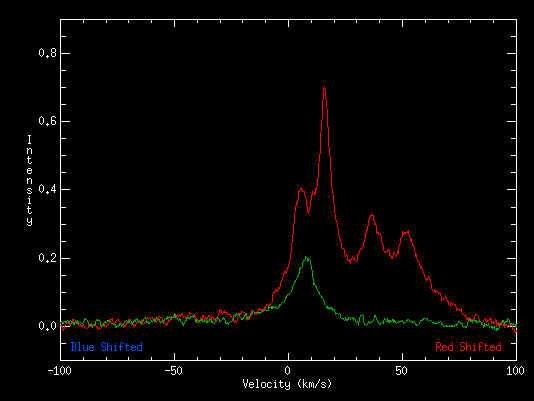Scientific Newsletter - November 6, 2001
|
Using SETI@home data to explore hydrogen distribution in the Galaxy Eric Korpela, Paul Demorest, Eric Heien, Carl Heiles, Dan Werthimer Hydrogen is the most abundant element in the universe. It forms the bulk of the mass of stars and giant planets. The Galaxy itself is filled with hydrogen, with rarified regions at densities as low as a few dozen atoms per cubic meter and star forming regions with densities as high as 20 million atoms per cubic meter. This gas takes part in the rotation of the Galaxy. It is clumped together in spiral arms. It is moved around by shock waves from supernova explosions, forming spherical shells of denser gas hundreds of light years in diameter. Where this gas is densest, new stars form. Some of these new stars will explode as supernovae, causing new shells of gas to form, and triggering new star formation. This feedback loop has been going on since the Galaxy formed. If we want to understand any of these mechanisms, it's important to understand how hydrogen is distributed in the Galaxy. The SETI@home data system presents a unique mechanism for looking at hydrogen in the Galaxy. It is situated at the largest radio telescope in the world, which provides the best available imaging resolution that can be achieved with a single telescope. Because the frequency band it receives is centered near the 1420.4 MHz frequency emitted by hydrogen, the data tapes output by the SETI@home data recorder can be analyzed to extract information about hydrogen distribution in the Galaxy.

Image of Sombrero galaxy courtesy European Southern Observatory, © 2000 Like the stars in the Galaxy, hydrogen is mainly distributed in a large disk, like the one shown (edge on) above. Down below we have a vertical cross section through the disk of the Galaxy near the sun. The sun is the yellow circle is embedded near the plane of the disk. The grey fluff respresents the hydrogen gas.


The other thing you will notice is that the shapes of the plots is different between the two. That is because the hydrogen in the Galaxy is moving with respect to us. Because it is moving, the radio waves it emits will either be red-shifted if it is moving away from us, or blue shifted if it is moving toward us. In the red spectrum above we see four obvious peaks in the spectrum, so we are seeing hydrogen moving at four different velocities. In the green spectrum we only see a single obvious peak. The reason for the difference is that hydrogen in the Galaxy rotates about the center of the Galaxy in a manner similar to the way the sun does. When we look out of the plane of the Galaxy, our line of sight leaves the dense hydrogen at a point relatively nearby. So in the green plot, we are seeing hydrogen that is nearby and is rotating around the Galaxy at about the same speed as the sun does. When we look along the line of sight along the plane of the Galaxy, we see hydrogen that is farther away, and is moving at a different speed and in a different direction than the sun is. That doesn't fully explain why there are peaks in the spectrum, though. There are peaks because hydrogen is not evenly distributed in the Galaxy. Hydrogen in the Galaxy is more concentrated in the Galaxy's spiral arms, and less concentrated elsewhere. The image below represents a top down view of the Galaxy. The yellow dot is the sun, and the red line is a line of sight that we have chosen to illustrate this point. The blue arrows show the direction that the sun and the gas in the spiral arms is moving as it orbits the center of the Galaxy. When we measure the spectrum, the only part of the velocity we can measure is the portion directed along the line of sight, shown by the green arrows. The gas in the spiral arm nearest the sun is moving at the same speed and direction as the sun, so its measured velocity will be near zero. Nearly all of the velocity of the next spiral arm is directed toward the earth. It is moving faster toward the sun than the sun is moving away from it, so it would appear blue shifted. The velocity of the gas in the farthest spiral arm is nearly perpendicular to the line of sight. It's not moving toward us as fast as we are moving away from it. Its radio emission would appear red-shifted. By studying the shape of the spectrum we can learn about where structures like spiral arms are located in the Galaxy. 
Now you know everything there is to know about hydrogen in the Galaxy. Not by a longshot! We astronomers don't know a tenth of what there is to learn about hydrogen in the Galaxy. That's why we're going to take the SETI@home data tapes, and use them to generate 11 million spectra like the ones above. We'll use the spectra to make maps of hydrogen distributions in the areas of the Galaxy visible to Arecibo. We will make these maps available to anyone who wants to use them to study the Galaxy. For more technical details about this project, you can check out a presentation given at a conference at the ``Seeing Through the Dust'' conference at the Dominion Radio Astrophysical Observatory in October by clicking here. |

©2024 University of California
SETI@home and Astropulse are funded by grants from the National Science Foundation, NASA, and donations from SETI@home volunteers. AstroPulse is funded in part by the NSF through grant AST-0307956.